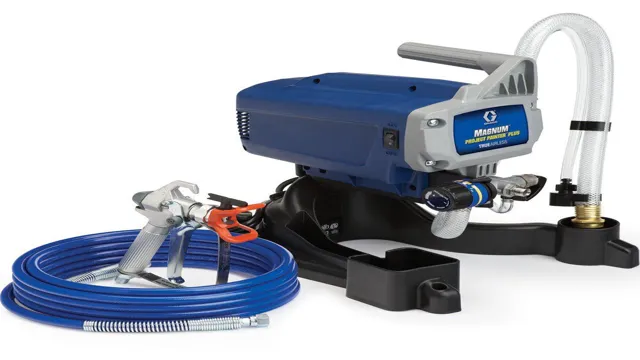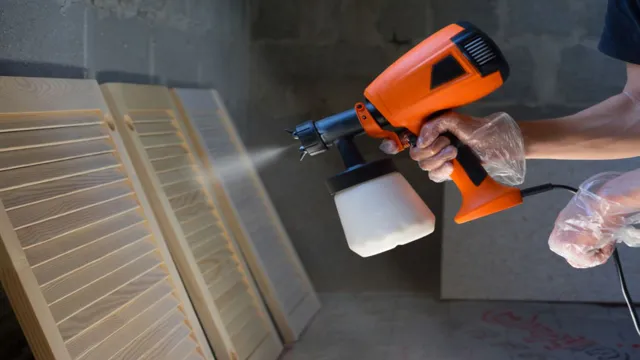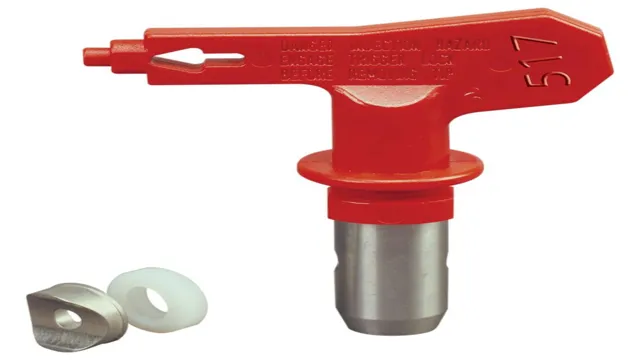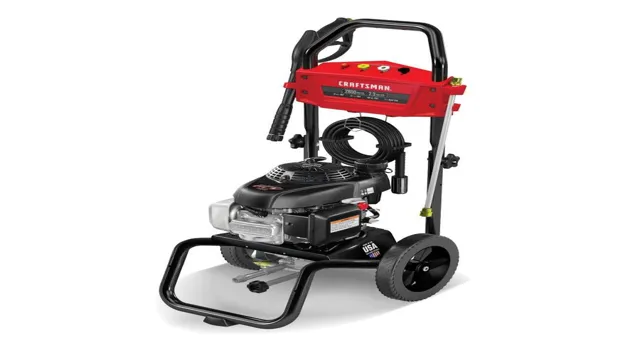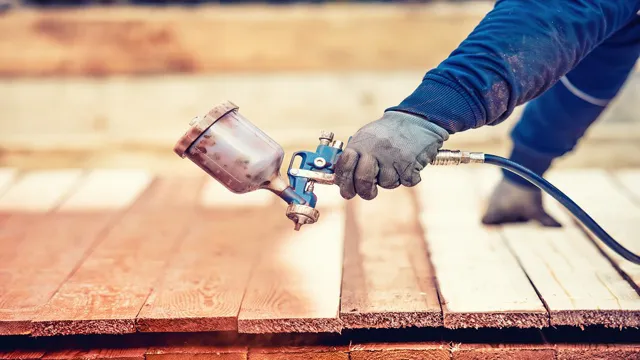How to Use Power Paint Sprayer to Achieve Professional-Looking Results

Looking to tackle a large painting project without the hassle of a brush and roller? Then a power paint sprayer might just be your solution! These tools are a fantastic, time-saving option for those looking to tackle large-scale painting projects. However, for those who’ve never used them before, the prospect of handling a powerful piece of equipment can be daunting. But don’t worry, with this guide, we’ll walk you through everything you need to know about how to use a power paint sprayer, from assembling the device to mastering spray patterns, to ensure a perfect finish every time.
So, grab your safety goggles and let’s get started!
Step 1: Preparation
When it comes to using a power paint sprayer, preparation is key to achieving a professional-looking paint job. Before you get started with the sprayer, it’s important to prepare the surface you will be painting on. This means removing any dirt, debris, or loose paint with a scraper or wire brush, and washing the surface with soap and water.
Once the surface is clean and dry, you can begin masking off any areas you don’t want to be painted, such as door handles or windows. Make sure you cover all surrounding surfaces with drop cloths or plastic sheets to protect them from overspray. Finally, make sure you have enough paint for the job and that it’s been properly mixed.
By taking the time to prepare your workspace and equipment, you’ll be setting yourself up for success when using a power paint sprayer.
Gather Materials and Equipment
If you’re planning to take on a DIY project, the first step is to gather all the necessary materials and equipment. To ensure that the project runs smoothly, organizing and preparing the work area is critical. When selecting the materials and equipment, make sure that they are appropriate for the task at hand.
Consider the specifications mentioned in the project instructions or any design blueprints. At the same time, it’s important to set a budget and stick to it as much as possible. You don’t want to spend a lot of money on equipment that may not be in use after your project is completed.
When gathering your equipment and tools, it’s a good idea to double-check safety guidelines and potential hazards. Investing in high-quality protective gear can make your DIY project much safer. Gather all the necessary tools, equipment, and safety gear can be time-consuming, but it sets the foundation for completing a successful DIY project.
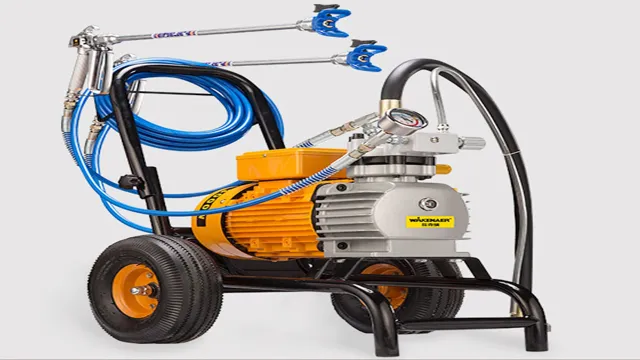
Prepare the Paint and Sprayer
To start with your paint job, it’s important to prepare both the paint and sprayer properly. The first step is picking the right paint for your project. Using a high-quality paint will ensure a better finish and longer-lasting results.
Next, it’s time to prepare the paint for the sprayer. You should always follow the manufacturer’s instructions for mixing the paint and thinning it down if necessary. Once the paint is prepared, it’s time to prep the sprayer.
Clean the sprayer thoroughly with water to remove any dust or debris that could affect the paint’s finish. When filling the sprayer, remember to strain the paint to remove any impurities. By taking the time to properly prepare the paint and sprayer, you’ll ensure a smooth and even finish for your paint job.
So, are you ready to get started on your project?
Step 2: Set-Up Sprayer
Once you have gathered your painting supplies, the next step to using a power paint sprayer is setting it up. First, make sure the sprayer is clean and free of any debris or old paint. Then, fill the paint container with your desired paint or primer.
Be sure to follow the manufacturer’s instructions for diluting the paint, if necessary. Next, attach the sprayer to an electrical outlet and turn it on to ensure that it is working properly. Adjust the spray nozzle to your preferred setting – such as horizontal, vertical, or round spray patterns – and make sure to test the sprayer on a scrap piece of material before beginning your painting project.
It’s also a good idea to wear protective gear, such as gloves and a face mask, while using a power paint sprayer to avoid any potential hazards. With these steps complete, you’re ready to start painting! So, you see how easy it is to set up a power paint sprayer to kick off your painting project.
Attach Spray Gun and Hose
Attaching the spray gun and hose is a crucial step in setting up your sprayer. First, make sure the machine is unplugged and the pressure relief valve is released before attaching the hose to the pump. Then, attach the spray gun to the end of the hose and tighten it securely.
Make sure all connections are tight to avoid leaks during operation. Once you have properly attached the spray gun and hose, you are ready to move on to the next step in preparing your sprayer for use. By following these simple steps, you can ensure a safe and effective operation of your sprayer equipment.
Remember, safety always comes first when working with any machinery.
Prime the Sprayer
When it comes to painting your interior walls, preparing the spraying equipment is essential for achieving the best possible results. The first step in setting up your sprayer is to prime it correctly. Priming involves filling the sprayer’s pump with paint and purging any excess air from the system.
This ensures consistent paint flow and even coverage on your walls. To prime your sprayer, begin by assembling all the equipment, including the sprayer, paint, and strainer. Pour the paint into the sprayer’s container and secure it tightly.
Next, connect the spray gun to the hose and turn the power on. You’ll need to release the pressure valve to allow the paint to flow through the hose until it reaches the gun. You should also adjust the sprayer settings according to the paint’s consistency and the surface you’re painting.
Proper priming guarantees that your paint sprayer will work efficiently, without any clogs, and give your walls a beautiful finish.
Step 3: Start Painting
Now that you have properly prepared your workspace and equipment, it’s time to start painting. Using a power paint sprayer is a great way to get smooth and even coverage with less effort than traditional painting methods. However, it’s important to remember to use proper safety gear, including a respirator mask and gloves, to protect yourself from the paint and any fumes.
You should also test the sprayer on a small area before starting your project to ensure that you have the right settings and spray pattern for the job. Once you are ready to begin, start at the top of the surface and work your way down in a consistent direction, overlapping each pass for maximum coverage. Keep the sprayer moving in a smooth motion to prevent drips and uneven spots.
With a little practice, you’ll be a power paint sprayer pro in no time!
Practice on a Scrap Surface
Now that you’ve prepped your canvas and practiced your strokes on a scrap surface, it’s time to start painting! The most important thing to remember is to start with thin layers of paint and build up gradually. This will allow you to correct any mistakes and create depth in your painting. You can also experiment with blending and layering different colors to create unique textures and tones.
Don’t be afraid to play around and try new techniques! Remember, the beauty of painting is in the process, not just the end result. So enjoy yourself and let your creativity guide you. With time and practice, you’ll become more confident in your abilities and discover your own personal style.
Keep refining your skills and soon enough you’ll be creating masterpieces that you never thought possible. So grab your brushes and let’s get started on this beautiful journey of art!
Hold the Sprayer Properly
When starting to paint with a sprayer, it’s important to hold the sprayer properly to ensure a steady and even application. The first step is to grip the sprayer handle with your dominant hand, keeping your fingers firmly wrapped around it. Your other hand should be used to support the sprayer from underneath, providing stability as you move it across the surface you’re painting.
Remember to keep the nozzle pointed perpendicular to the surface and maintain a consistent distance between the sprayer and the object being painted. This will help prevent any accidental drips or uneven coverage. By holding the sprayer properly, you’ll be able to achieve a professional-looking finish that will impress any onlookers.
Apply Even Coats
Now that you have prepped your painting surface and chosen the right color, it’s time to start painting! The key to achieving a smooth and even finish is applying even coats of paint. To do this, start from the top of your surface and work your way down in a methodical manner. Whether you’re using a brush or roller, make sure to apply the paint in long, sweeping motions and avoid going over areas that have already been painted.
If you do need to go over a section, wait until the first coat has dried completely before applying a second coat. Remember, it’s better to apply multiple thin coats than one thick coat, which can lead to drips, sags, and other imperfections. By applying even coats of paint, you’ll ensure a flawless finish that makes your project look professional and polished.
Step 4: Clean-up
After using a power paint sprayer, it’s essential to clean it thoroughly to avoid clogs or malfunctions during the next use. First, unplug the device and remove the remaining paint from it. You can pour any unused paint back into the can, but make sure you strain it to remove any debris.
Then, fill the paint sprayer’s container with water and turn the device on. Let it run for several minutes until the water coming out of it is clear. Once done, remove and disassemble the nozzle and soak it in warm, soapy water.
Use a soft-bristled brush to remove any stubborn residues from the nozzle and other parts of the device. Finally, rinse the nozzle and other parts with clean water, dry them with a clean cloth, and reassemble the paint sprayer. Keeping your paint sprayer clean and well-maintained can ensure its longevity and proper functioning.
So, remember to clean your power paint sprayer after every use.
Flush the Sprayer
To ensure your sprayer is ready for the next use, it’s important to flush it out properly. This step ensures that all pesticides, herbicides, or other chemicals are removed from the system, reducing the risk of contamination. First, empty any remaining fluid from the sprayer tank, and dispose of it safely and responsibly.
Next, fill up the sprayer tank with clean water and recirculate it through the system for around ten minutes. This will flush out any remaining residue. Finally, empty the tank and allow the sprayer to dry completely before storing it away.
Following these steps will help to ensure that your sprayer remains in top condition and ready for your next application. Remember, it’s important to follow all of the manufacturer’s instructions and use precaution when cleaning and handling chemicals.
Clean the Nozzle and Gun
Once you’re finished painting, it’s crucial to clean the nozzle and gun properly. Leaving them dirty can lead to clogs and make it difficult to use them again in the future. Thankfully, the process is straightforward and easy to follow.
Start by disassembling the nozzle and removing any leftover paint using a brush or cloth. Soak the parts in solvent for 30 minutes to an hour to dissolve any dried paint. Afterward, rinse the parts with warm water and dry them thoroughly.
For the gun, use a brush or cloth to remove any excess paint, then fill a bucket with water and run it through the gun to flush out any remaining paint. Repeat until the water in the bucket runs clear. Remember always to wear protective gloves and eyewear when cleaning the gun and nozzle.
Taking care of your equipment will ensure that it lasts a long time and works properly when you need it again.
Tips for Using a Power Paint Sprayer
Using a power paint sprayer can be a time-saving and efficient way to complete a painting project. However, it can be a bit intimidating for first-time users. The first step is to choose the right spray tip according to the type of paint and surface you will be working on.
A smaller tip is ideal for detailed work, while a larger tip is better suited for larger surfaces. It’s important to read the manufacturer’s instructions and safety precautions before operating the sprayer. When spraying, keep the sprayer perpendicular to the surface and maintain a consistent distance from the surface to avoid uneven coverage or drips.
It’s also recommended to use a spray shield when working close to corners or edges to prevent overspray. Lastly, clean your sprayer thoroughly after each use to prevent clogs and extend its lifespan. By following these tips, you can master the art of using a power paint sprayer and achieve a professional finish for your painting projects.
Adjust the Pressure
When using a power paint sprayer, adjusting the pressure can make a big difference in the outcome of your project. If the pressure is too high, the paint can become oversprayed and leave an uneven finish. On the other hand, if the pressure is too low, the paint may not come out smoothly and evenly.
To find the sweet spot, start by testing the pressure on a scrap piece of material. If it’s working well, move on to the actual project. If not, make adjustments until you find the perfect pressure.
Remember, finding the right pressure is crucial to achieving a professional-looking finish. By taking the time to experiment and adjust, you’ll be well on your way to painting like a pro.
Wear Protective Gear
When it comes to using a power paint sprayer, it’s essential to take safety precautions seriously. One of the most critical safety measures is wearing the appropriate protective gear. This means donning a respirator or mask to prevent inhalation of paint fumes, eye protection to protect your eyes from dust and debris, and gloves to protect your hands from chemicals and paint splatter.
Investing in high-quality protective gear may be expensive, but it’s a small price to pay for safeguarding your health and well-being. In the long run, wearing protective gear will prevent serious injuries and illnesses, such as chemical burns, respiratory problems, and eye damage. By prioritizing your safety and being cautious, you can ensure a successful and safe experience using a power paint sprayer.
Maintain Proper Distance and Angle
Maintaining the proper distance and angle when using a power paint sprayer is crucial for achieving a smooth and even finish. Holding the sprayer too close to the surface can cause oversaturation, leading to drips and uneven coverage. On the other hand, holding the sprayer too far away can result in a dry mist that doesn’t adhere properly to the surface.
To find the sweet spot, start by holding the sprayer about 6-8 inches away from the surface and adjust as needed. It’s also important to hold the sprayer at a perpendicular angle to the surface to ensure even coverage. Tilting the sprayer can cause the paint to pool in certain areas, resulting in an uneven finish.
With a little practice and a mindful approach, you’ll be able to achieve professional-looking results with your power paint sprayer. So, don’t be afraid to experiment with different distances and angles until you find what works best for your particular project.
Conclusion
In conclusion, using a power paint sprayer is like wielding a mighty wand that magically transforms your space with color and precision. It allows for faster, more efficient painting, and achieving professional-looking results without breaking a sweat. With the tips and tricks outlined above, you’ll be a paint-spraying pro in no time, dazzling your friends with your expertly painted walls and leaving your enemies green with envy.
So, go forth and conquer, dear paint-sprayer, for your newfound power is not to be taken lightly!
FAQs
What is a power paint sprayer?
A power paint sprayer is a device used to apply paint quickly and efficiently, without the need for brushes or rollers.
How do I use a power paint sprayer?
To use a power paint sprayer, you should first read the instructions manual provided by the manufacturer. Generally, you will need to fill the reservoir with paint, prime the pump, and adjust the nozzle for the desired spray pattern.
Can I use a power paint sprayer indoors?
Yes, power paint sprayers can be used indoors, but you should take proper precautions such as wearing a mask and covering nearby surfaces to protect them from overspray.
What types of paint can be used in a power paint sprayer?
Most types of paint can be used in a power paint sprayer, including latex, oils, stains, and varnishes. However, you should check with the manufacturer to ensure compatibility with your specific paint product.
Can I use a power paint sprayer for small projects?
Yes, power paint sprayers can be used for small projects. However, you may need to adjust the nozzle for a smaller spray pattern, and it may take more time to set up and clean up the sprayer than it would to use a brush or roller.
What are the benefits of using a power paint sprayer?
Power paint sprayers are faster and more efficient than traditional painting methods, allowing you to cover more surface area in less time. They also provide a more uniform and consistent finish, with less overspray and dripping.
How do I clean my power paint sprayer?
To clean your power paint sprayer, you should first empty any remaining paint from the reservoir. Then, fill the reservoir with water or a cleaning solution recommended by the manufacturer, and run the sprayer until the solution runs clear. Finally, disassemble the sprayer and clean all the individual parts thoroughly with a brush and the cleaning solution.

